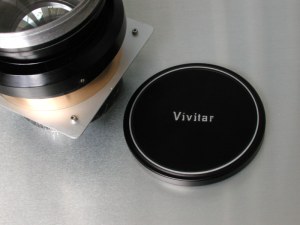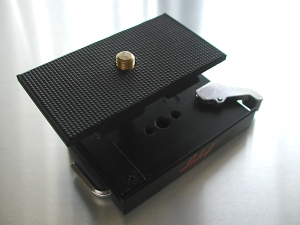 One man's junk is another man's treasure! |
 |
Aero Technica 45 Probably thanks to the experience gained during WWII the Linhof Aero Technica 45 evolved. Compact motorized camera system primarily for high quality oblique aerial photography. Large 4x5 in. or 6x9 cm images on 5 in. or 70 mm perforated rollfilm (approx. 150 exposures per magazine load). llllllllllllllll |
 |
Master Technica 45 According many photographers this camera is the non plus ultra.
Allthough our Speed Graphic sometimes referred to as "The Poor Man's Master Technika" , we know our Pacemaker beats the Master on one important feature at least - The focal plane shutter. We have to disappoint Linhof owners who want to mount the Aero Ektar and want to experiment....Sorry, it won't work even if it is possible at all to get it mounted, you still will need a big black hat to control the shutter time. llllllllllllllll |
 |
Master Graf ???
Hybrid Camera? No way, just a Century Graphic (2-1/4x3-1/4). I must admit the anatomical grip is a nice add-on but at a price these days! llllllllllllllll |

|
Early Model
Got in an early Aero Ektar with a Serno EA350.
|
 |
Specs
We only can give the specs from the model we have EE.
Dimensions:
|
....
 Mounting the Aero Ektar
Mounting the Aero EktarAero Combo - refer as Mod II #I Spacer and retaining ring The whole project was discussed by extensive phone and E-mail communication with Jo Lommen (Jo is an expert on restoring Press Cameras and much more.)in Roermond (NL). This was a very important start after buying the Aero Ektar EE*****. We looked over different possibilities to mount the beast. In our pursuit we've found images of David Burnett and came in contact. As David kindly shared photographs of his own configuration, we decided to go for this solution.
In our minds this was not extremely difficult to do but... llllllllllllllll
|

 In progress....
In progress....#II The lensboard Construction.
The material used was brushed aluminium with a thickness of 1mm
|

 
  Official release aug. 1948 |
Alternate mounting solution. Graflex Combo - refer as Mod I
By now you will have read any syllable about the mounting of the Aero Ektar, but there are more ways...
We have found this construction consisting of an original Graflex lensboard with a mounted tube.
N O T E :: There is one big advantage though on using this setup. Changing lenses is much easier and faster with this tube!
With this knowledge under your belt and our tips, please feel free to pick your choice.
|

 
|
Alternate mounting solution. part II Detailed view
Detail of the .above construction:
Mount the lensboard the usual way...and screw in the Aero to the end stop.
Note:
|
 |

|
Mod I complete for rent... Try before you leap.
Biggest advantange of this mount is, the lens can be used without any adaptions on the camera or lensboard!
If you live near John.D and own a Speed Graphic, it is possible to try this combination on your personal camera. Rental possible for 3 days(contiguous) at a reasonable price...
|

|
Accessories and other paraphernalia... part I Lens cap
The only lens cap I've found is this one shown together with the AE.
|

|
Accessories and other paraphernalia... part II Tripod mount
The best and most reliable quick mount tripod adapter is the Linhof Quickfix II
|

|
Accessories and other paraphernalia... part III Polaroid back
To do quick tests or just as a master negative (type 55) you will need a Polaroid cassette type 545.
During the time several were made from the type 550. All are usable, however if you want to be the sharpest guy on the block, you probably want the 545 Pro.
Shown here is the development with Polaroid type 56 resulting in 45 sec. After pulling out the Polaroid it will count down and give an audible beep to remind you to peel apart the film.... More on Filmholders. |
 |
Accessories and other paraphernalia... part IV Filterholders
Can anybody shed some light on it? Yes, Oliver Kruse could, thank you Oliver!
The mount consists of two parts holding and securing the drop-in filter.
|






|

|
Filter Holder ?? llllllllllllllll
The filters left measured 6In and were also meant for the Aero Ektar 7In. More likely meant for the 12In.
llllllllllllllll |
  |
Aero Ektar 307mm 12 In
llllllllllllllll
|
 |
Aero Ektar 153mm 6 In
llllllllllllllll |

 |
Working with the Aero Ektar f 2.5 A few notes After you did mount the Aero and adjusted your Kalart RF you're ready to shoot!
Beware of the the very small dof at all times. To give a little understanding see our Palm screen.
If you focus within 6ft you need the GG and of course a tripod. A second screen dump will show the Values for a distance of 10 meter.
If you use a palm already read below:
Pcam description: One more thing, even mounted on a sturdy tripod, try to avoid camera movement by using a long cable release. Have fun! |
 |
Radio Activity
The rear elements of the Aero-Ektar lenses are famous for having thorium glass that is a mild gamma radiation emitter. This lens element does, indeed, emit gamma radiation, approximately 3 mR/hr. according to my Geiger counter. I looked into what exactly this means to the timid photographer. My brief web research indicates that if you put this lens in your (big) pocket for 8 hours a day, 5 days a week, after six months you would have been exposed to the 5000 mR maximum permissable annual occupational exposure. So, don't grind it up and eat it, use it for a pillow, make it part of your uniform, or put your body in contact with this device on a regular basis.
Beyond a couple feet away, the detected level of radiation disappears into the background.
llllllllllllllll See our link for Mr Briggs for more information on Radio Activity! |

As you probably understand by now, this shopping list is not intended for your local Mall. Instead you have to google and search for the Speed Graphic, the Aero Ektar as well the Mask no 2.
The spacer, retaining ring and drilled lenshole will add some more difficulties, look out for a good machinist...
It takes a while to get it and a long while to get it right...
We get many requests about mounting and/or adapting the Aero Ektar 7In for the smaller formats (6x6cm and 35mm)

Mod 2 Combo
![]()

What do I need to build the Aero Ektar - Speed Graphic:
We give our comments right here to avoid unnecessary bandwidth ;-):
This lens was originally designed to shoot aerial
photography on 5 by 5 inch roll film. (9 by 9 inch for the 12In Aero Ektar)
Doing so and Shooting 35mm or 6x6cm is really underutilizing these lenses.
Only a small part of the image circle would be used this way!
Someone with machinist access should modify it for 4x5 or 5x7 film formats! Slight vignetting will occur on 5x7!
If you want to do M=1 on a 8x10 ..no problem It will cover the format with ease.
More on our page about the Image Circle.

Need Help?
Want info on how to do it yourself ?
Use our TalkBack button!
Have an Aero yourself, want to mount it?
Need a Lensboard?
Use the TalkBack button!
 Legal!
Legal!
 About
About
 Tribute MB
Tribute MB
 Whois
Whois
 Aldis
Aldis
 Aero Project
Aero Project
 The Workout
The Workout
 Memorandum
Memorandum
 Image Circle
Image Circle
 TestBench
TestBench
 Gallery
Gallery 
 Encounter...
Encounter...
 "User Group"
"User Group"
 User Group/Signup
User Group/Signup
 Promo Movie
Promo Movie
 Tribute
Tribute
 Graflens
Graflens
 Lenses+
Lenses+
 Holes+
Holes+
 My Pacemakers
My Pacemakers
 Books
Books
 Speedlights
Speedlights
 UserGallery
UserGallery
 WICF
WICF
 Contact
Contact
 Acquire
Acquire
 ABC
ABC
 Filmholders
Filmholders
 Whatsnew
Whatsnew
 Graflinks
Graflinks
 Start Page
Start Page
 Dancing with Speeds
Dancing with Speeds
 Femke
Femke

















